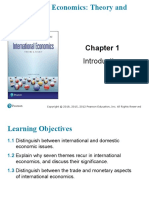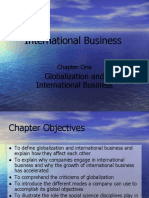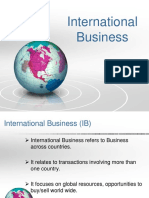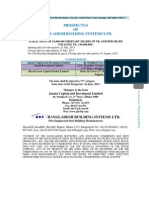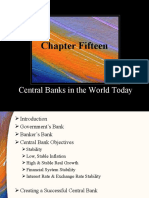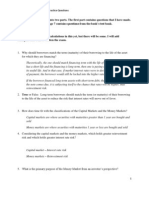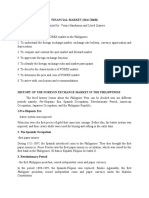0 ratings0% found this document useful (0 votes)
48 viewsM01 Krugman 46657 09 IE C01 F GE
M01 Krugman 46657 09 IE C01 F GE
Uploaded by
KemalArdiansyahPresentation Chapter 1 International Krugman Obstfeld
Copyright:
© All Rights Reserved
Available Formats
Download as PPT, PDF, TXT or read online from Scribd
M01 Krugman 46657 09 IE C01 F GE
M01 Krugman 46657 09 IE C01 F GE
Uploaded by
KemalArdiansyah0 ratings0% found this document useful (0 votes)
48 views18 pagesPresentation Chapter 1 International Krugman Obstfeld
Original Title
M01_Krugman_46657_09_IE_C01_F_GE
Copyright
© © All Rights Reserved
Available Formats
PPT, PDF, TXT or read online from Scribd
Share this document
Did you find this document useful?
Is this content inappropriate?
Presentation Chapter 1 International Krugman Obstfeld
Copyright:
© All Rights Reserved
Available Formats
Download as PPT, PDF, TXT or read online from Scribd
Download as ppt, pdf, or txt
0 ratings0% found this document useful (0 votes)
48 views18 pagesM01 Krugman 46657 09 IE C01 F GE
M01 Krugman 46657 09 IE C01 F GE
Uploaded by
KemalArdiansyahPresentation Chapter 1 International Krugman Obstfeld
Copyright:
© All Rights Reserved
Available Formats
Download as PPT, PDF, TXT or read online from Scribd
Download as ppt, pdf, or txt
You are on page 1of 18
Chapter 1
Introduction
Copyright 2012 Pearson Education. All rights reserved.
Preview
What is international economics about?
International trade topics
Gains from trade, explaining patterns of trade,
effects of government policies on trade
International finance topics
Balance of payments, exchange rate
determination, international policy coordination
and capital markets
International trade versus finance
Copyright 2012 Pearson Education. All rights reserved.
1-2
What Is International Economics About?
International economics is about how
nations interact through:
trade of goods and services, flows of money,
and investment.
International economics is an old subject,
but continues to grow in importance as
countries become tied more to the
international economy.
Nations are now more closely linked than
ever before.
Copyright 2012 Pearson Education. All rights reserved.
1-3
What Is International Economics About?
(cont.)
International trade as a fraction of the
national economy has tripled for the U.S. in
the past 40 years.
Both imports and exports fell in 2009.
Compared to the U.S., other countries are
even more tied to international trade.
Copyright 2012 Pearson Education. All rights reserved.
1-4
Fig. 1-1: Exports and Imports as a
Percentage of U.S. National Income
Source: U.S. Bureau of Economic Analysis
Copyright 2012 Pearson Education. All rights reserved.
1-5
Fig. 1-2: Exports and Imports as
Percentage of National Income in 2007
Source: Organization for Economic Cooperation and Development
Copyright 2012 Pearson Education. All rights reserved.
1-6
Gains from Trade
Several ideas underlie the gains from
trade.
1. When a buyer and a seller engage in a
voluntary transaction, both can be made better
off.
Norwegian consumers import oranges that they
would have a hard time producing.
The producer of the oranges receives income that it
can use to buy other things that it desires.
Copyright 2012 Pearson Education. All rights reserved.
1-7
Gains from Trade (cont.)
2. How could a country that is the most (least)
efficient producer of everything gain from trade?
Countries use finite resources to produce what they are
most productive at (compared to their other production
choices), then trade those products for goods and
services that they want to consume.
Countries can specialize in production, while consuming
many goods and services through trade.
Copyright 2012 Pearson Education. All rights reserved.
1-8
Gains from Trade (cont.)
3. Trade benefits countries by allowing them to
export goods made with relatively abundant
resources and imports goods made with
relatively scarce resources.
4. When countries specialize, they may be more
efficient due to larger-scale production.
5. Countries may also gain by trading current
resources for future resources (international
borrowing and lending) and due to international
migration.
Copyright 2012 Pearson Education. All rights reserved.
1-9
Gains from Trade (cont.)
Trade is predicted to benefit countries as a
whole in several ways, but trade may harm
particular groups within a country.
International trade can harm the owners of
resources that are used relatively intensively in
industries that compete with imports.
Trade may therefore affect the distribution of
income within a country.
Copyright 2012 Pearson Education. All rights reserved.
1-10
Patterns of Trade
Differences in climate and resources can explain
why Brazil exports coffee and Australia exports
iron ore.
But why does Japan export automobiles, while the
U.S. exports aircraft?
Why some countries export certain products can
stem from differences in:
Labor productivity
Relative supplies of capital, labor and land and their use in the
production of different goods and services
Copyright 2012 Pearson Education. All rights reserved.
1-11
Effects of Government Policies on Trade
Policy makers affect the amount of trade through
tariffs: a tax on imports or exports,
quotas: a quantity restriction on imports or exports,
export subsidies: a payment to producers that export,
or through other regulations (ex., product specifications)
that exclude foreign products from the market, but still allow
domestic products.
What are the costs and benefits of these policies?
Copyright 2012 Pearson Education. All rights reserved.
1-12
The Effects of Government Policies
on Trade (cont.)
If a government must restrict trade, which policy
should it use and how much should it restrict
trade?
If a government restricts trade, what are the costs
if foreign governments respond likewise?
Trade policies are often chosen to cater to special
interest groups, rather than to maximize national
welfare.
Governments tend to adopt tariffs, then negotiate
them down in exchange for reduction in trade
barriers of other countries.
Copyright 2012 Pearson Education. All rights reserved.
1-13
International Finance Topics
Exchanging risky assets such as stocks and
bonds can benefit all countries by
diversification that reduces the variability
of income another source of gains from
trade.
Most international trade involves monetary
transactions.
Many monetary events have important
consequences for international trade.
Copyright 2012 Pearson Education. All rights reserved.
1-14
Balance of Payments
Governments measure the value of exports and
imports, as well as the value of financial assets
that flow into and out of their countries.
Trade deficits, where countries import more than they
export in value, may be offset by net inflows of financial
assets.
The official settlements balance, or the balance of
payments, measures the balance of funds that
central banks use for official international
payments.
All three values are measured in the governments
national income accounts.
Copyright 2012 Pearson Education. All rights reserved.
1-15
Exchange Rate Determination
Exchange rates are an important financial issue for
most governments.
Exchange rates measure how much domestic
currency can be exchanged for foreign currency
and thus affect:
how much goods denominated in foreign currency
(imports) cost in the domestic country.
how much goods denominated in domestic currency
(exports) cost in foreign markets.
Some exchange rates change continually (float)
while others are fixed for periods of time.
Copyright 2012 Pearson Education. All rights reserved.
1-16
International Policy Coordination
In an integrated economy, one countrys economic
policies usually affect other countries as well,
leading to the need for some degree of policy
coordination.
Depends on type of exchange rate regime.
Capital markets, where money is exchanged for
promises to pay in the future, have special
concerns in an international setting:
Currency fluctuations can alter the value paid.
Countries, especially developing ones, might default on
debt.
Copyright 2012 Pearson Education. All rights reserved.
1-17
International Trade Versus Finance
International trade focuses on transactions
involving movement of goods and services
across nations.
International trade theory (chapters 28) and
policy (chapters 912)
International finance focuses on financial or
monetary transactions across nations.
International monetary theory (chapters 1318)
and policy (chapters 1922)
Copyright 2012 Pearson Education. All rights reserved.
1-18
You might also like
- Globalization and The Multinational Firm: Chapter OneDocument28 pagesGlobalization and The Multinational Firm: Chapter OneiMQSxNo ratings yet
- m01 Krugman 46657 09 Ie c01 FDocument18 pagesm01 Krugman 46657 09 Ie c01 FAnh NguyễnNo ratings yet
- © Pearson Education Limited 2015.: All Rights Reserved. 1-1Document20 pages© Pearson Education Limited 2015.: All Rights Reserved. 1-1Vu Van CuongNo ratings yet
- Krugman - Chap 1Document22 pagesKrugman - Chap 1Lodhi Ismail0% (1)
- Lecture 1Document52 pagesLecture 1khalilziya3No ratings yet
- Chapter 1 - IntroductionDocument17 pagesChapter 1 - Introductionvintosh_pNo ratings yet
- Eleventh Edition, Global EditionDocument21 pagesEleventh Edition, Global EditionBilge SavaşNo ratings yet
- Preview: What Is International Economics About? International Trade TopicsDocument12 pagesPreview: What Is International Economics About? International Trade TopicsbeyzahnmNo ratings yet
- Lecture 1Document7 pagesLecture 1K59 Le Nhat ThanhNo ratings yet
- 01 Intro International EconomicsDocument17 pages01 Intro International Economicsexams_sbsNo ratings yet
- Lecture 1Document7 pagesLecture 1K60 Nguyễn Trần Bảo NgọcNo ratings yet
- Test MergedDocument505 pagesTest Mergedyomna1823oNo ratings yet
- BEC 420 International EconomicsDocument21 pagesBEC 420 International EconomicsPresley SaviyeNo ratings yet
- Materi 1 IntroductionDocument22 pagesMateri 1 Introductionnikmatus olichaNo ratings yet
- TT 01Document22 pagesTT 01AHMAD ALINo ratings yet
- Chapter 1Document26 pagesChapter 1haigiangofficialNo ratings yet
- Chapter 1 - Overview About Multinational Corporate FinanceDocument38 pagesChapter 1 - Overview About Multinational Corporate FinanceVân TrangNo ratings yet
- Current Multinational Challenges and The Global EconomyDocument26 pagesCurrent Multinational Challenges and The Global EconomyJeep RajNo ratings yet
- EVGE-IE 21-22 - Lesson 3 - Krugman Ch. 1Document16 pagesEVGE-IE 21-22 - Lesson 3 - Krugman Ch. 1서영섭No ratings yet
- Drivers of GlobalisationDocument45 pagesDrivers of Globalisationamlan dasNo ratings yet
- Globalization and International BusinessDocument20 pagesGlobalization and International BusinesspranitfloraNo ratings yet
- Lec01 MncsDocument49 pagesLec01 MncsMuhammad Saqib AtaNo ratings yet
- Slides Prepared by Thomas BishopDocument17 pagesSlides Prepared by Thomas Bishopadin blehNo ratings yet
- LN01 EitemanDocument27 pagesLN01 EitemanwangyuNo ratings yet
- Multinational Financial Management: Opportunities and ChallengesDocument39 pagesMultinational Financial Management: Opportunities and ChallengesSylvia Al-a'maNo ratings yet
- CHP 1Document38 pagesCHP 1SUBA NANTINI A/P M.SUBRAMANIAMNo ratings yet
- Globalization & The MNCDocument26 pagesGlobalization & The MNCAllwynThomasNo ratings yet
- Balance of PaymentsDocument28 pagesBalance of PaymentsMoataz mohamedNo ratings yet
- Business 10 Chapter 4 Part 2Document15 pagesBusiness 10 Chapter 4 Part 2cecilia capiliNo ratings yet
- 7EC503 International Economics For Business and Finance: 01 - IntroductionDocument20 pages7EC503 International Economics For Business and Finance: 01 - IntroductionWahab Nurudeen OpeyemiNo ratings yet
- Lecture Chapter 1Document14 pagesLecture Chapter 1Mai HiếuNo ratings yet
- CH 1Document12 pagesCH 1gNo ratings yet
- Globalization & The Multinational Firm: Chapter OneDocument27 pagesGlobalization & The Multinational Firm: Chapter OneHu Jia QuenNo ratings yet
- Lec 1 - Chap1&3Document38 pagesLec 1 - Chap1&3TACN-1TC-19ACN Luong Khanh LinhNo ratings yet
- International Financial EnvironmentDocument49 pagesInternational Financial EnvironmentPanashe MachekepfuNo ratings yet
- Daniels Ib11 Ch01Document17 pagesDaniels Ib11 Ch01Niki NicolaouNo ratings yet
- International Finance Lecture NotesDocument30 pagesInternational Finance Lecture NotesIRENE WARIARANo ratings yet
- Introduction of International BusinessDocument42 pagesIntroduction of International Businesstrustme77100% (1)
- Itbp - 01Document19 pagesItbp - 01UJJWAL SHARMANo ratings yet
- International Business: Dr. Dinkisa KenoDocument30 pagesInternational Business: Dr. Dinkisa KenoerkiyhunNo ratings yet
- MOD VI Nature of International FinaceDocument18 pagesMOD VI Nature of International Finacemanisha rajNo ratings yet
- The Global Trade and Investment EnvironmentDocument21 pagesThe Global Trade and Investment EnvironmentCarlo Niño GedoriaNo ratings yet
- Multinational Financial Management - Opportunities and ChallengesDocument27 pagesMultinational Financial Management - Opportunities and ChallengesHương NguyễnNo ratings yet
- International Business ManagementDocument42 pagesInternational Business ManagementMihir BansalNo ratings yet
- CH 3 International Flow of FundsDocument13 pagesCH 3 International Flow of Fundspagal larkiNo ratings yet
- Chapt 12Document50 pagesChapt 12KamauWafulaWanyamaNo ratings yet
- Chapter 1 An Overview of International FinanceDocument31 pagesChapter 1 An Overview of International FinancePhương ThùyNo ratings yet
- The Balance of PaymentsDocument52 pagesThe Balance of PaymentsSHOBANA96No ratings yet
- CH01Document38 pagesCH01Tasnova AalamNo ratings yet
- International Trade Theory and Development StrategyDocument48 pagesInternational Trade Theory and Development StrategyIrish Dela FuenteNo ratings yet
- BOP-Group 2Document35 pagesBOP-Group 2Waleed ElsebaieNo ratings yet
- Part 1-International Finance and The Multinational Firm.Document57 pagesPart 1-International Finance and The Multinational Firm.MUSABYIMANA DeogratiasNo ratings yet
- Daniels IBT 16e Final PPT 01Document48 pagesDaniels IBT 16e Final PPT 01rola mohammadNo ratings yet
- International Financial EnvironmentDocument54 pagesInternational Financial EnvironmentrysonNo ratings yet
- International Finance - Short Notes (Theory)Document20 pagesInternational Finance - Short Notes (Theory)Amit SinghNo ratings yet
- Ib 1Document23 pagesIb 1Divik TyagiNo ratings yet
- International Business Chatp 1 0Document18 pagesInternational Business Chatp 1 0rahafNo ratings yet
- Unit 1 IfmDocument19 pagesUnit 1 IfmMohammed HussainNo ratings yet
- Ibt ReviewerDocument9 pagesIbt ReviewertutanesjeremaeNo ratings yet
- Intermediate Financial Management 12th EditionDocument8 pagesIntermediate Financial Management 12th EditionKemalArdiansyahNo ratings yet
- M07 Krugman 46657 09 IE C07 F GEDocument42 pagesM07 Krugman 46657 09 IE C07 F GEKemalArdiansyahNo ratings yet
- Public Spending and Public Choice: Market FailureDocument1 pagePublic Spending and Public Choice: Market FailureKemalArdiansyahNo ratings yet
- Appendix Bu DinyDocument7 pagesAppendix Bu DinyKemalArdiansyahNo ratings yet
- Notes On Foreign Exchange Markets - Gr12Document22 pagesNotes On Foreign Exchange Markets - Gr12lwazindlovu468No ratings yet
- BUS 496 - Project 1 - Group 2Document31 pagesBUS 496 - Project 1 - Group 2Luan PhamNo ratings yet
- Economics Unit 4 NotesDocument23 pagesEconomics Unit 4 NotestaymoorNo ratings yet
- On January 1 2014 A U S Company Purchased 100 ofDocument1 pageOn January 1 2014 A U S Company Purchased 100 ofMuhammad ShahidNo ratings yet
- Chapter 1, 2 and 3Document40 pagesChapter 1, 2 and 3aubrey jasmira lopezNo ratings yet
- Journal of Factors Effecting UnemploymentDocument12 pagesJournal of Factors Effecting UnemploymentHidayah ZulkiflyNo ratings yet
- Bangladesh Building Systems LimitedDocument116 pagesBangladesh Building Systems Limitedshobu_iuj100% (1)
- Foreign Exchange MarketDocument3 pagesForeign Exchange MarketVasim ShaikhNo ratings yet
- MDI Finance Compendium 2016Document29 pagesMDI Finance Compendium 2016Khyati DahiyaNo ratings yet
- FOREX Lecture-MergedDocument31 pagesFOREX Lecture-Mergedmisonim.eNo ratings yet
- Global Marketing Chapter 2Document59 pagesGlobal Marketing Chapter 2Rifqi HanifzarNo ratings yet
- (CFA) (2015) (L2) 03 V5 - 2015 - CFA二级强化班PPT - 经济学 - 何旋1Document98 pages(CFA) (2015) (L2) 03 V5 - 2015 - CFA二级强化班PPT - 经济学 - 何旋1Phyllis YenNo ratings yet
- Week 7 Learning EbookDocument169 pagesWeek 7 Learning EbookAnniNo ratings yet
- Cambridge International AS & A Level: Economics 9708/22 October/November 2022Document17 pagesCambridge International AS & A Level: Economics 9708/22 October/November 2022kutsofatsoNo ratings yet
- Chapter Fifteen: Central Banks in The World TodayDocument53 pagesChapter Fifteen: Central Banks in The World TodaySadia AbidNo ratings yet
- Part 15 - International Financial MarketsDocument43 pagesPart 15 - International Financial MarketsPRks ChaulagainNo ratings yet
- International Finance Notes by Akintayo TemitopeDocument15 pagesInternational Finance Notes by Akintayo TemitopeAkintayo TemitopeNo ratings yet
- 426 Exam 2 Questions AnswersDocument25 pages426 Exam 2 Questions AnswersIlya StadnikNo ratings yet
- Data Mining For Small Shops Empowering Brick-And-Mortar Stores Through BI Functionalities of A Loyalty Program1Document18 pagesData Mining For Small Shops Empowering Brick-And-Mortar Stores Through BI Functionalities of A Loyalty Program1hengky.75123014No ratings yet
- Sample QuestionDocument9 pagesSample QuestionYussone Sir'YussNo ratings yet
- Chapter 8 Bop-Fe 2021Document20 pagesChapter 8 Bop-Fe 2021Sireen IqbalNo ratings yet
- Equitable PCI Bank v. NG Sheung NgorDocument2 pagesEquitable PCI Bank v. NG Sheung Ngorcarmelafojas100% (3)
- CIA CIA3 SU10 OutlineDocument33 pagesCIA CIA3 SU10 Outlinececilia.sarnoNo ratings yet
- The Foreign Exchange Market: QuestionsDocument3 pagesThe Foreign Exchange Market: QuestionsCarl Aziz100% (1)
- International Financial ManagementDocument13 pagesInternational Financial ManagementParvesh AghiNo ratings yet
- Open-Economy Macroeconomics: The Balance of Payments and Exchange RatesDocument26 pagesOpen-Economy Macroeconomics: The Balance of Payments and Exchange RatesCharles Reginald K. HwangNo ratings yet
- A Reflection About The Global Business Environment NewDocument16 pagesA Reflection About The Global Business Environment NewAkintunde AyeniNo ratings yet
- GLOBAL FINANCE WITH E-BANKING (Part 3)Document4 pagesGLOBAL FINANCE WITH E-BANKING (Part 3)Jenina Rose SalvadorNo ratings yet
- Reviewer IbtDocument7 pagesReviewer IbtMaia Carmela JoseNo ratings yet
- Learning ObjectivesDocument6 pagesLearning ObjectivesVernie O. HandumonNo ratings yet



